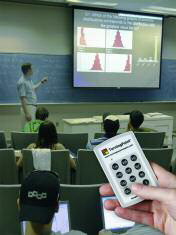
Gone are the days of straight lecturing by instructors and note taking by students. Instead, clickers, which look like small remote controls, are allowing students to become active participants and instructors to gauge how well concepts are sinking in.
An instructor using a classroom response system poses multiple-choice questions to students via an overhead or computer projector during a lecture. Students respond using the handheld clickers, which transmit infrared or radio-frequency signals to a receiver attached to the instructor’s computer. Software reads the responses, compiling data that is seen on an overhead screen.
The technology has taken off in such departments as chemistry, economics, physics and astronomy, psychology, biomedical engineering, and human and organizational development, as well as at the medical and nursing schools.
“Historically,much of the interest in clickers came from instructors teaching science courses and large lecture classes,” says Derek Bruff, assistant director of the Vanderbilt Center for Teaching and a senior lecturer in mathematics, who has done extensive research on the subject. “As you lead a class discussion with 15 students, you get a sense of what they are struggling with and can respond appropriately. Once you hit a hundred or 200 students, there are very few options for having that kind of meaningful interaction.
“Clickers scale up very well–the bigger the class, the more payoff, because clickers can be used to organize a lecture in ways that really get students talking to each other, generating ideas, thinking hard about the content,”Bruff adds.
Instructors may pose factbased questions that serve to keep students on pace with classroom discussion. Students’ responses are shown in real time, allowing the instructor to gauge their understanding and tailor the lecture accordingly. 12 F a l l 2 0 0 7 Or, instructors may ask questions that generate discussion.
One of the best advantages of such a system, Bruff says, is the immediacy of the technology. “I don’t have to wait until the end of the semester to determine whether the students are understanding things the way I want them to. Instead, I leave every class with a pile of data that tells me what the students do and do not understand.”
For more information about classroom response systems and resources on campus, visit www.vanderbilt.edu/cft/crs.htm.